The Virtues of Time Over Money
The Brazilian newspaper A Tarde interviewed me about Street Use. Their question: does the street use of technology impact the poor differently than the rich?
My answer: “Everyone tries to personalize technology. The poor have time but no money; and the rich have money but no time. So the poor use their time to modify technology and the rich use money to personalize it. I always find what people do with time more interesting than what they do with money.”
Below: A door I saw in India made with rough wood in a mud-brick house. No money, lots of time.

Great Minds Think Alike: the Bicycle Lawnmower!
Over at Treehugger, Warren McLaren has rounded up all the examples of this ingenious, indigenous, “labor-saving” invention that he could find.
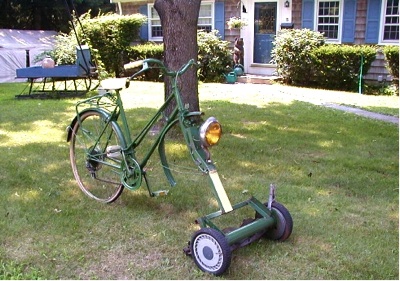
It is apparent that thousands of people who have to mow the lawn decided there must be an easier way and had exactly the same idea: Why not hook the mower to a bike? And so the bikemower is born in a thousand of garages around the country. Judging from the pictures, they are still in the garages. Most of the pics rounded up by McLaren look as if they were taken at garage sales. I have my doubts that the bike mower is very useful, or easier to use than pushing on your feet.
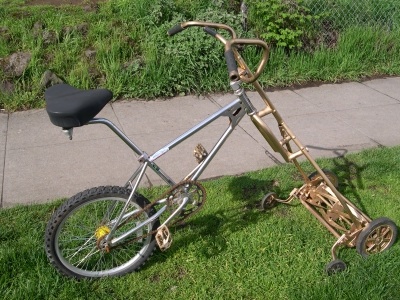
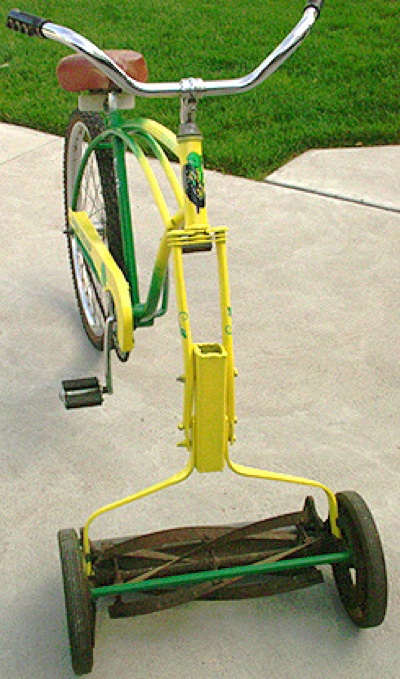
For the full set see the Treehuger post above.
Mobile Bicycle Public Phone Booth
In Uganda, Ken Banks found this ingenious mobile phone booth. He wrote up the caption and posted his picture to Afrigadget, one of my favorite street use sites. His report:
I met this phone operator off Kampala Road this afternoon, who was riding round on this bike. Luckily he was a fellow Liverpool supporter so we hit it off straight away – and he let me take a photo of his BodaPhone setup. Pretty neat, and with a spare battery to allow him to stay on the road longer. Uganda is really hotting up on the mobile front, with two new operators about to enter the market towards the end of the year.
Ken translates the price as 200 Ugandan Shillings per unit is equivalent to about 11 cents US.

Power Cart

This prototype of a prototypical street cart is artist Mouna Andraos’ idea. From the artist’s proposal: “An old idea from yesterday’s streets adapted to serve the needs of today’s urban dwellers, the Power Cart is a mobile unit that delivers alternative power to people in the streets. Street vendors have traditionally played an important role in defining the urban environment and often speak to the current social and cultural context of a city. In most parts of the world (and if the weather permits it), the street is a place where social interactions abound and where commerce rules, and street vendors around the globe bring to local populations the things they need right at their door steps. Knife sharpening in India, refills of gas in Africa, fake Gucci bags in Paris and chair massages in New York, the Power Cart looks and feels like another service for the city of today. Need a charge on your cell phone? Your laptop is about to die and you really need to check that email? Or maybe there is no power around you at all? Where ever you might be in the world, hail the Power Cart for a quick fix. Let the Power Cart owner turn the crank for you and get the electricity you need, one minute of cranking at a time.”

You Can’t Have Too Many Screens
Adam Sender runs the Exis Capital Management Inc., a hedge fund in New York City. He also owns a $100 million modern art collection which he would like to house in an old church in the Hamptons. He has a lot of money and a need for a lot of information. This photo of him in his New York office in January 2007 was shot by Bloomberg News. As you can see, his desk is part performance art, part futuristic demo of what some believe work will be like in the future.

These flat screens were never meant to be piled up and around like this, but when these displays are free (as they essential are to this rich guy), they become a fantastic street use example of where display technology is headed. In this photo I counted 25 screens. Most of Sender’s screens don’t need to be interactive since they appear chiefly as displays of stock movements, which means they are good candidates for electronic wallpaper. If these screens were stitched together into a single desktop as many dual screen sets are (like my own desktop) it might be hard to keep track of where your control cursor was (at least until someone figured out a good way to highlight it across all that real estate).
These screens remind me of a project I once worked on. About 8 years ago, I was part of a small group invited by Steven Spielberg to brainstorm about a future film he was launching. There were some writer types (like myself), some technologists, a few futurists, and one or two science fiction authors, all members of the Global Business Network. Speilberg flew us to Venice Beach, California and holed us up in the Shutters on the Beach Hotel for a day and a half. I remember the spectacular beach was fogged in, so we spent the days in a dim conference room, as a constant stream of assistants whizzed in and out the whole time. We were working from a short story by Philip K. Dick, a sketch really (no script), which was set in the near future. Our assignment was to describe the details of what life would look like in Washington DC in the year 2050. Forecast the future of cars, bedrooms, office space in as realistic and accurate way possible. The movie, of course, was Minority Report.
At the time I had been trying to imagine the office of the future. I suggested to the film team that we would be surrounded by a single seamless screen in an arc, and that we would stand up and gesture into it. I had observed that when you think on your feet you have different thoughts. I like to think while I walk or pace because I feel my whole body is thinking then. It may turn out to be a short-term anomaly that today we think while we are sitting. Perhaps if the right technology were around we’d always think with our entire body in motion. I know I would rather move while mining for new ideas. With that in mind I offered the wall-sized screen arc that you stand before and act. You would interact with the information at a slight distance using your arms. Spielberg’s team found a great designer to make the idea real, and in a brilliant stroke of genius, they turned it into ballet by adding music.
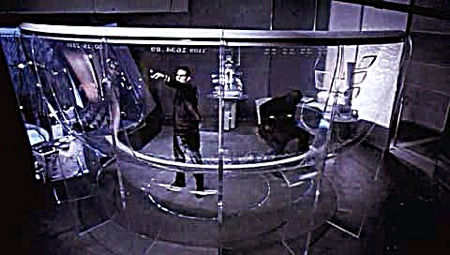
I was simply describing the office I want. So far, Adam Sender is closest to this vision made real, although it is a long way from my ideal. I would be interested in hearing about other experiments in day-to-day surround-display. Can anyone point me to street-ready multiple displays hacked in home offices? How useful are they really? Can you keep track of what is happening behind you? Why not go up, rather than behind?
Plastic Bottle Chandeliers
This is all I know: English-Russia says “These days in some parks of St. Petersburg you can meet chandeliers made of used plastic bottles..”
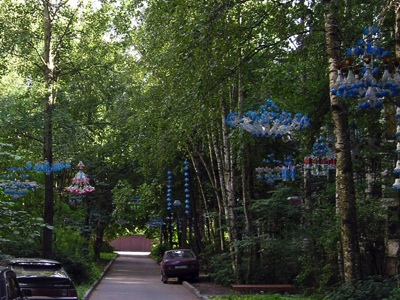
Sock Exchange
Todd Lapin found this cool “sock exchange” in a San Francisco laundromat (the Bernal Bubbles Laundromat, Cortland Avenue, Bernal
). 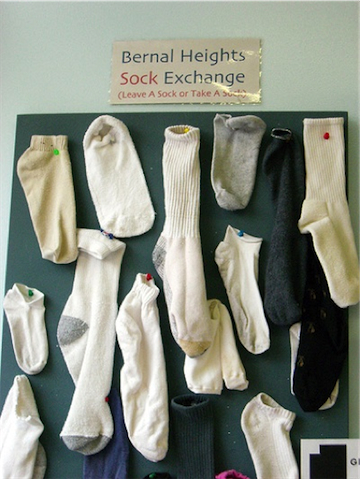
Soviet Self-Made Lawnmower
One of my favorite street-use sites is English-Russia. They frequently feature novel ways that Russians create their own technology. The latest example is this clever home-made lawn mower. The site doesn’t say much about how it was built, but it seems to created around an electric motor and bicycle parts. About all they say about the machine is: “This particular lawnmower still works and sometimes is used by this Russian man on his “dacha”, the summer wooden cottage where he spends some of his weekends, like many other Russians do.”
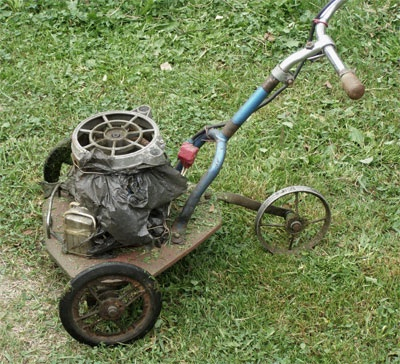
Public Cartoon Blackboard
According to a BBC news item datelined Nairobi, a one Humphrey Barasa has “has been drawing cartoons on the [Kenyan] bus stop shelter for the last six years.”
The cartoons, which Mr Barasa draws on the face of the shelter, highlight various issues – from politics and politicians, to health and social issues – and act as a pictorial analysis of current affairs….. He has won many fans, who visit the shelter every day to view his latest masterpiece. “It’s very, very excellent work. It always gives me inspiration and that’s why I pass here every day,” said one of his fans.
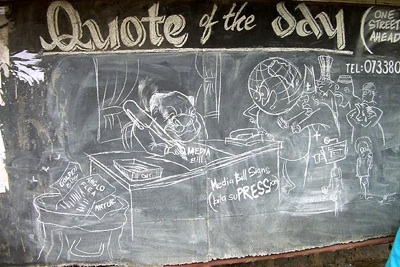
Work-in-progress Notice
I am in the middle of upgrading the Movable Type software beneath this blog, as well as re-designing aspects of Street Use and my other blogs. If you notice little holes and bugs, it’s us not you. Please be patient, although I’d appreciate a note if you detect something out of kilter.


